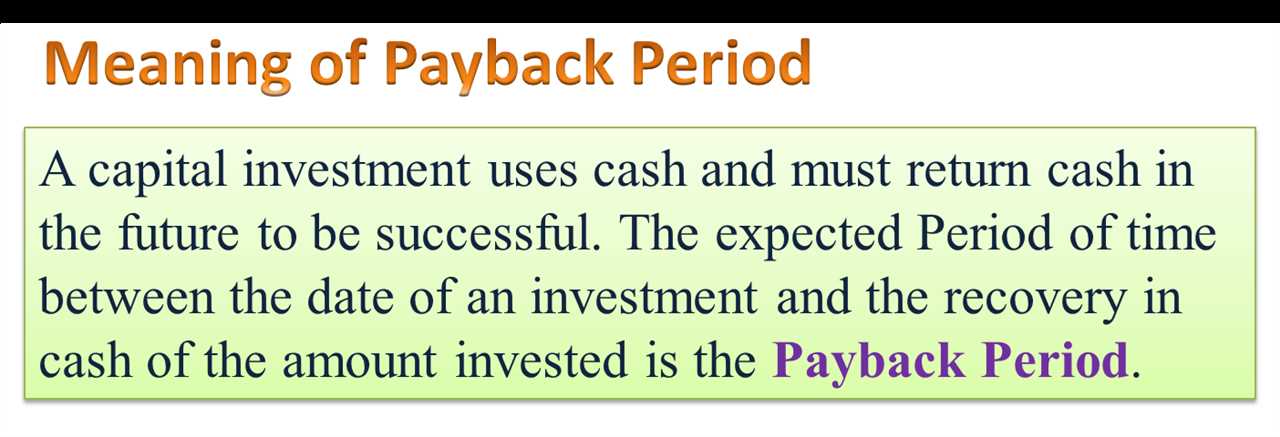What is Payback Period Formula and Calculation?
The payback period is a financial metric used in corporate finance to measure the time it takes for a company to recoup its initial investment. It is a simple and widely used method for evaluating the profitability of an investment project.
The payback period formula is straightforward. It is calculated by dividing the initial investment by the annual cash inflows generated by the project. The result is the number of years it will take for the company to recover its investment.
For example, if a company invests $100,000 in a project and expects annual cash inflows of $25,000, the payback period would be 4 years ($100,000 / $25,000 = 4). This means that it would take the company 4 years to recoup its initial investment.
The payback period calculation is based on the assumption that cash inflows occur evenly throughout the year. However, in reality, cash inflows may not be evenly distributed. Therefore, the payback period should be used as a rough estimate rather than an exact measure.
The payback period is often used in conjunction with other financial metrics, such as net present value (NPV) and internal rate of return (IRR), to make investment decisions. It provides a quick and easy way to assess the risk and profitability of an investment project.
The payback period is a financial metric used to evaluate the time it takes for a company to recoup its initial investment in a project or investment. It is a simple and straightforward measure that helps businesses assess the profitability and risk associated with different investment options.
At its core, the payback period represents the length of time required to recover the initial investment through the cash flows generated by the project. It is often expressed in years or months, depending on the duration of the investment.
The payback period is particularly useful for businesses looking to assess the liquidity and cash flow implications of an investment. By calculating the payback period, companies can determine how long it will take to recover their investment and whether the project aligns with their financial goals and objectives.
When evaluating the payback period, businesses should consider their desired timeframe for recouping the initial investment. A shorter payback period indicates a quicker return on investment, which may be preferable for companies seeking faster cash flow generation. On the other hand, a longer payback period may be acceptable for projects with higher potential returns or strategic significance.
How to Calculate Payback Period

The payback period is a simple and widely used method to evaluate the profitability of an investment. It measures the time it takes for an investment to generate enough cash flows to recover the initial investment. Calculating the payback period involves a straightforward formula:
Step 1: Gather the necessary information
Before calculating the payback period, you need to gather the following information:
- The initial investment amount
- The expected cash flows for each period
Step 2: Determine the cash inflows
Identify the cash inflows for each period. These are the cash flows generated by the investment, such as sales revenue or rental income.
Step 3: Calculate the cumulative cash flows
Calculate the cumulative cash flows for each period by adding up the cash inflows. Start with the initial investment and add the cash inflows for each period until the cumulative cash flows equal or exceed the initial investment.
Step 4: Find the payback period
The payback period is the number of periods it takes for the cumulative cash flows to equal or exceed the initial investment. It can be calculated by finding the period where the cumulative cash flows cross the initial investment amount.
For example, if the initial investment is $10,000 and the cumulative cash flows for each period are as follows:
- Period 1: $2,000
- Period 2: $3,000
- Period 3: $4,000
- Period 4: $3,000
- Period 5: $2,000
Importance of Payback Period in Corporate Finance
The payback period is a crucial concept in corporate finance as it helps businesses evaluate the profitability and risk associated with an investment. It provides a simple and straightforward measure of how long it takes for a company to recoup its initial investment.
One of the main reasons why the payback period is important is that it helps businesses make informed decisions about whether to invest in a particular project or not. By calculating the payback period, companies can assess the time it will take to recover their investment and determine if it aligns with their financial goals and objectives.
Additionally, the payback period is valuable in assessing the risk associated with an investment. A shorter payback period indicates that the investment will generate cash flows more quickly, reducing the risk of not recovering the initial investment. On the other hand, a longer payback period may indicate higher risk as it takes more time to recoup the investment.
The payback period also allows businesses to compare different investment opportunities and choose the one that offers the shortest payback period. This helps companies prioritize their investments and allocate resources effectively. By selecting projects with shorter payback periods, businesses can ensure a faster return on investment and improve their overall financial performance.
Furthermore, the payback period is a useful tool for assessing the liquidity of an investment. It helps businesses understand how quickly they can convert their investment into cash, which is crucial for managing cash flow and meeting short-term financial obligations.
Overall, the payback period is an essential metric in corporate finance that provides valuable insights into the profitability, risk, and liquidity of an investment. By considering the payback period, businesses can make informed investment decisions, prioritize projects, and effectively manage their financial resources.

Emily Bibb simplifies finance through bestselling books and articles, bridging complex concepts for everyday understanding. Engaging audiences via social media, she shares insights for financial success. Active in seminars and philanthropy, Bibb aims to create a more financially informed society, driven by her passion for empowering others.
